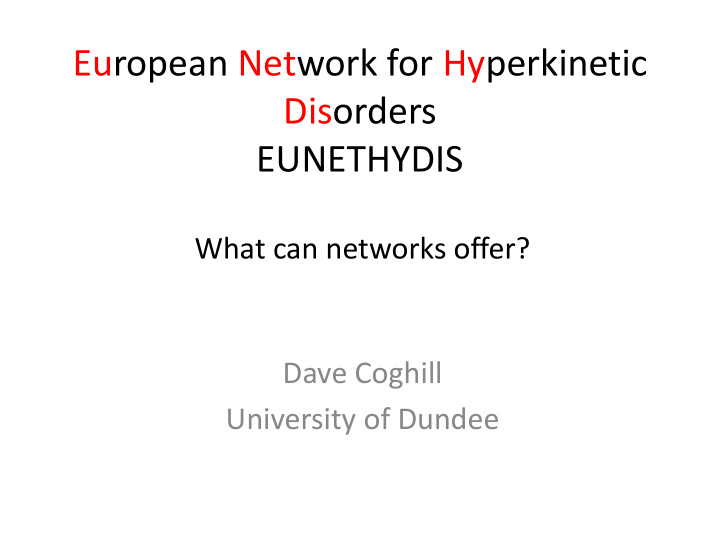



European Network for Hyperkinetic Disorders EUNETHYDIS What can networks offer? Dave Coghill University of Dundee
EUNETHYDIS • • Founded 22 years ago to Strong focus on collaborative facilitate collaborative interdisciplinary research research into the causes and including; consequences of ADHD / – Genetics Hyperkinetic Disorders – Behavioural neuroscience • Focuses both on basic science – Neuroimaging and clinical research – Neuropsychology • – Neuropsychopharmacology Core membership of around 50 senior European academics – Phase I – IV Clinical Trials from psychiatry, psychology (Pharmacological and non- pharmacological) and neuroscience – Pharmacovigalence • 40 Associate members from – Pharmacogenetics North America, Australia, Asia and Africa
Challenges in Paediatric Psychopharmacology in Europe • Practice outstrips evidence • Research has been US dominated but there are very significant differences in clinical practice between Europe and US • Under recognition and under treatment of disorders • Against a background of a media driven picture of over diagnosis and over treatment • Controversial treatments – Psychostimulants – “abuse” “turn children into zombies” – Antidepressants – “ suicidality ” – Antipsychotics – “chemical cosh”
• Need to focus on three areas – Poorly studied core treatments for core patients with core disorders • SSRIs in depression • Atypical antipsychotics in schizophrenia and bipolar disorders – Well studied treatments in new populations • Psychostimulants in intellectual disability and autism – New drugs/formulations
PERS (Paediatric European Risperidone Studies) • A programme of research developed in response to a specific call of the FP7 Cooperation Work Programme “HEALTH - 2009-4.2-1: Adapting off- patent medicines to the specific needs of paediatric populations ” . • The overarching goal is to perform a series of clinical studies that will lead to a Paediatric Use Marketing Authorisation (PUMA) for risperidone in children and adolescents with CD. • EUNETHYDIS was involved in: – The development of the original application – The design of the 3 component studies that make up the Paediatric Investigation Plan (PIP) • Short term RCT • Long term open label and randomised discontinuation trial • Long term observational safety study – Troubleshooting implementation of these protocols – Implementing the trials – Analysing and interpreting results
European Registration Trials for Lisdexamfetamine (Shire) • Lisdexamfetamine a new amfetamine prodrug for treating ADHD owned by Shire. • Licensed for use in North America and Brazil. • Currently under development for licensing in Europe. • EUNETHYDIS members have; – Provided scientific and clinical advice and support to Shire in the development and design of clinical trials • Including mid trial modifications required as a consequence of EMA policy changes – Acted as Principal Coordinating investigator for the 4 trials – Provided and identified trial sites across Europe – Assisted in training of sites – Assisted in the interpretation and presentation of results
• Similar to the LDX studies EUNETHYDIS has played a significant role in European studies for Atomoxetine (Lilly), and Medikinet XL (Medice) • Development and implementation of studies in areas that industry funding is not generally available e.g. – Psychostimulants in children with intellectual disability – Atomoxetine in children with 22q11.2 deletion syndrome – Methylphenidate in prison populations • Advice for industry with respect early and mid stage development of potential new compounds or new uses for existing compounds – Novel ADHD treatments – Treatments for child and adolescent anxiety and depression • Developing understanding of MOA and predictors of response for licensed and unlicensed drugs using a range of techniques including – Behavioural neuroscience – Neuroimaging – Neuropsychopharmacology – Pharmacogenetics • Large scale pharmacovigalence studies of ADHD medication • Development of evidence based clinical guidelines
Network Challenges • Further develop and broaden the network to provide better coverage of child and adolescent mental health • Address funding issues – Internal – External • Particualrly funding for studies of off patent medications, new indications and clinical sub groups.
Recommend
More recommend